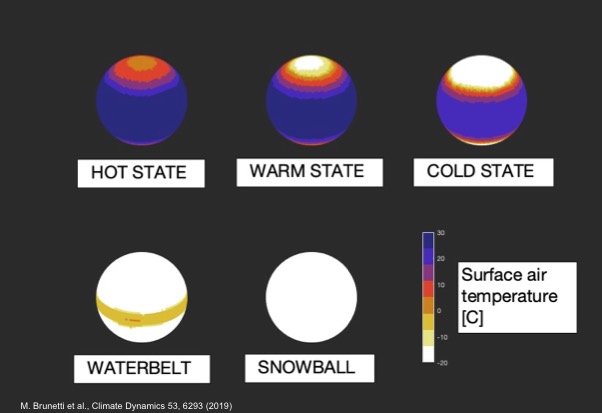Climate multistability

Reconsidering the habitability in the light of climate multistability
PI: Jérôme Kasparian, Maura Brunetti, Emeline Bolmont
Collaborators: Ehouarn Millour, Francis Codron, Martin Turbet and the Generic PCM developers’ team (LMD)
Funding: NCCR PlanetS and DIP
Dates: 01.09.2022 – 31.08.2026
Description:
Most habitable zone determinations are currently based on energy-balance models or radiative-convective models adapted from terrestrial models, taking into account the expected/assumed exoplanetary conditions. For instance, in energy-balance models, the balance between the incoming stellar energy flux and the outgoing radiation defines an equilibrium temperature, which should be compatible with the presence of surface liquid water.
On the global scale, models display alternative stable states due to several feedbacks (ice-albedo, clouds, radiation...). These alternative stable states represent different climatic conditions, strongly impacting life and providing an interpretation to large extinction episodes associated with brutal climate changes.
Phase 1 - Earth-like planets
In the frame of this project, we consider the whole range of potential conditions offered by the various stable climate states in the assessment of habitability in exoplanets. In particular, we will focus on the water cycle, the carbon cycle, ocean configurations and parametrization, as well as the orbital parameters. This will be both explored in simple models (EBM and 1D radiative-convective models), and developed in a planetary general circulation model (GCM), the Generic Planetary Climate Model (Generic PCM) from the Laboratoire de Météorologie Dynamique (LMD, in Paris).
Phase 2: Considering non-Earth-like planets
Exoclimate multistability will be investigated in a wider range of conditions, more representative of the variety of exoplanets conditions, also corresponding to different evolution stages of the planetary system. This will rely on developments of the models performed in Project 1, e.g. an improved representation of the ocean dynamics. This also includes adapting the emission spectrum of the star, or the atmospheric composition, to consider a wider range of candidate planets from various planetary systems.
Furthermore, we will seek for model intercomparisons, for instance using the MITgcm and the generic PCM, in order to assess the robustness of the first results, in terms of the existence of multiple stable states, but also their conditions (included processes and feedbacks, range of temperature values, etc), and their stability and the size of their basin of attraction, hence the probability to retain a given (habitable) state for sufficiently long times.
Phase 3: Coupling time scales
A key challenge for climate simulations in the context of planetary evolution, and even more when life is to be considered, is the mutual interaction, on “long” times scales, between the climate, geologic and tectonic processes, and life. Here, “long” refers to tens of thousands to millions of years, well beyond the “short” timescale of climate, which lies in the 100 to 1000 years range. On Earth, these couplings include weathering of minerals, changes to the carbon cycles, or changes to the atmosphere composition under the action of living organisms.
With inputs from collaborations from evolutionary biologists, planetologists , and geologists (including Prof. L. Caricchi, Prof. S. Castelltort), we will apply asynchronous coupling between climatic components evolving on different time scales (for instance, using and developing the Planetary Evolution Model from the LMD). More specifically, the tectonic and biological state of the planet will be provided as input conditions for the climate models, which will define the evolution over `short’ time scales, which in turn will be used to adjust the “slow” evolution of the planet (for example, in terms of sedimentary rates and weathering), and so on.
Job opportunities:
- One PhD (Siddharth Bhatnagar): Reconsidering the habitability in the light of climate multistability.
- One master student (Marine Levraz): Investigating the effect of dynamics on climate with an EBM.
